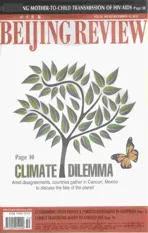CRISIS FOCUS The Dollar Shockwave
2010-12-26
CRISIS FOCUS The Dollar Shockwave
As the ongoing recession exhausts the traditional instruments of monetary policy, the U.S. Federal Reserve is fi ring up its money printing machines as it prepares for new rounds of quantitative easing (QE). And, w ith investors seeking higher returns, more QE w ill drive hot money into high-yield emerging market econom ies, which could inflate dangerous asset bubbles. Dan Steinbock, Research Director of International Business at the India, China and America Institute, and visiting fellow at the Shanghai Institutes for International Studies(China), talked about the potential damages of QE in an article toBeijing Review. Edited excerpts follow:
The U.S. Federal Reserve and the Obama administration remain rhetorically wedded to maintaining a “strong dollar.” But it is the dollar’s weakness that has boosted U.S. corporate earnings since the crisis erupted, propelling the Dow Jones Industrial Average above 11,000 for the first time since May. Since early 2002, the dollar has fallen by one third against major currencies, and recently this decline has intensified.
Since the end of August, when U.S.Federal Reserve Chairman Ben Bernanke argued for another round of QE, the dollar has plunged more than 7 percent against a basket of half a dozen major currencies.
The full impact of America’s QE2 w ill not be domestic, because the net effect w ill be a weaker dollar as speculators bet on its decline.
M eanwhile, developing countries are moving in the opposite direction. In October, the People’s Bank of China,China’s central bank, responding to the tw in threats of inflation and asset bubbles, raised its one-year deposit and lending rates by 25 basis points—the first increases since 2007. Right before the Fed acted, the Reserve Bank of India raised its benchmark short-term interest rate by 25 basis points to fight inflation,and China’s central bank now indicates that it might raise interest rates further.A fter the Fed’s move, Brazil is also preparing to retaliate. “It’s no use throw ing dollars out of a helicopter,” as Brazilian M inister of Finance Guido Mantega put it. Soon afterward, Germany’s finance m inister called U.S. policy “clueless,”w hile his South A frican counterpart thought that the Fed’s move undermined the G20 leaders’ “spirit of multilateral cooperation.”
Today, however, global econom ic integration and interdependence are much deeper than in the 1930’s. As Chen Deming, China’s M inister of Commerce,recently complained, “The U.S. issuance of dollars is out of control and international commodity prices are continuing to rise.” As a result, “China is being attacked by imported inflation.”
The impact of the Fed’s policy and hot money has been dramatic. In the third quarter of this year, China’s foreign exchange reserves increased by $194 billion, which far exceeded the country’s$66 billion trade surplus and $23 billion in inflows of foreign direct investment.At least part of the difference can be attributed to hot money.
M ost importantly, a disruptive decline of the U.S. dollar, or a disruptive appreciation of the Chinese yuan, could hinder not only China’s grow th, but also global recovery. In the 1990s, emerging and developing econom ies were still dependent on G7 grow th. In the past decade, these countries have, as the Organization for Economic Cooperation and Development research has shown,become dependent on Chinese grow th.Any decline in China’s grow th would thus significantly undermine poverty reduction in the emerging world.
In a global economy, the decisions of the leading countries’ central banks have global implications. And, in a world where the G7 no longer drives global grow th, printing money is like playing w ith fi re.
